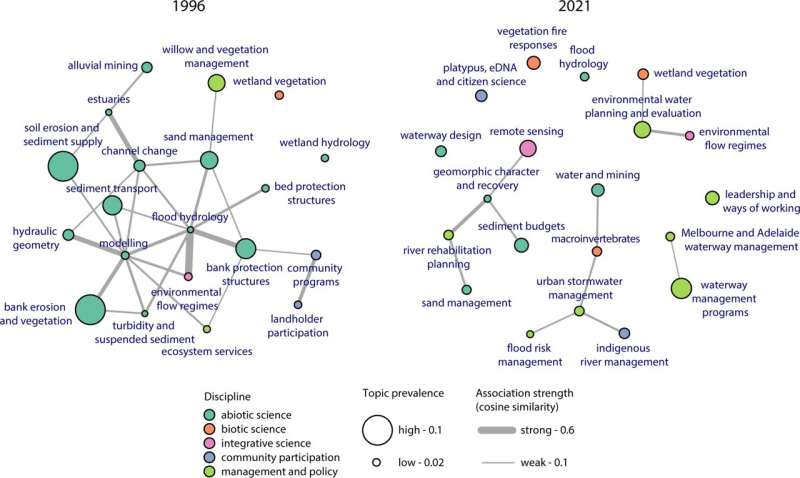This article has been reviewed according to Science X's editorial process and policies. Editors have highlighted the following attributes while ensuring the content's credibility:
fact-checked
peer-reviewed publication
trusted source
proofread
Nature-based management enhances river resilience, shows study

Research paper in Communications Earth and Environment shows progress in Australia towards United Nations goals, making rivers more able to recover from flood, drought and other impacts.
In July 2022, the 120-kilometer Wollombi Brook, which flows north into the Hunter Valley in New South Wales, suffered one of its biggest floods on record. And it held up remarkably well, says Professor Kirstie Fryirs of the School of Natural Sciences at Macquarie University. "Yes, there was widespread inundation, but the flood waters were slower and the vegetation prevented large scale erosion and sediment movement.
"All the hard work that a very active community put into nature-based rehabilitation for more than 20 years, such as continuous streamside revegetation, played a role in this outcome." It is one of the best examples in Australia of sustainable environmental restoration in the management of rivers, she says.
It represents the sort of transformation Professor Fryirs and research fellow Dr. Kathryn Russell of the University of Melbourne think the multi-billion-dollar river management industry worldwide should be working towards.
"It's important," says Dr. Russell, "as part the worldwide effort to achieve river sustainability and resilience to drought, fire and flood." More specifically, the researchers say, Wollombi Brook encapsulates the sort of changes we need to make to meet river health goals set by the United Nations in its Decade on Ecosystem Restoration to 2030.
Adopting the UN environmental goals as principles in river management will be essential to conserve and improving river health, make effective use of diverse and traditional knowledges, integrate grassroots to the global action, improve the robustness and cost efficiency of restoration efforts, and secure river resilience to climate change and natural disasters.
Accelerating and upscaling
Dr. Russell is lead author and Professor Fryirs is second author of a paper recently published in Communications Earth and Environment. Nine additional authors from a diversity of backgrounds also contributed. The paper does not investigate river management directly, but rather how the industry behind it in Australia has been changing to meet those goals. The verdict is that progress has been solid but patchy.
"We're doing a lot of good things at the local level," Professor Fryirs says, citing several examples in eastern NSW. Dr. Russell provided urban examples of Norman Creek in Hanlon Park/Bur'uda across the river from the University of Queensland in Brisbane and the Sunbury Integrated Water Management Plan, which will protect creeks and safeguard water supplies in western Melbourne.
"But this work needs upscaling and better resourcing—from short sections of river to corridors to catchments—if we are going to get anywhere close to achieving some of the UN's global goals," Professor Fryirs says. "Australia seems to have reached a pivotal point with fires, floods and droughts. If we don't get this right at this time, then we may well have lost that moment."
Analysis and recommendations
The authors analyzed the spread of papers delivered to the long-running Australian Stream Management (ASM) conference over the 25 years between 1996 to 2021. From their analysis they extracted information on how the structure and the approaches of Australia's river management industry have changed over time, and what the successes and failures have been.
They found that the river management industry has matured over those 25 years, with increasing diversity and collaboration between its different components. However, there has been little measurable expansion of the participation of local communities and of the use of adaptive management or 'learning by doing' and 'learning from mistakes."
In contrast to parts of the world where expensive engineering solutions—big dams, channels and pipelines—are still prevalent, such as China, India and South America, the researchers say that what they have found in Australia is typical of much of the developed world like Europe and North America. "The trends are quite similar," says Dr. Russell. "While our analysis is local, our recommendations are global."
On the basis of their analysis the authors made five recommendations to support sustainable development—that practitioners from different areas of management should work together and with communities (including First Nations communities) holistically; that nature-based, rather than engineering solutions should be implemented; that greater resources should be devoted to adaptive river management; that knowledge and understanding should be preserved by institutions; and that practitioners should have more influence in formulating government policy.
More information: Kathryn Russell et al, Evolution of a river management industry in Australia reveals meandering pathway to 2030 UN goals, Communications Earth & Environment (2023). DOI: 10.1038/s43247-023-00748-y
Journal information: Communications Earth & Environment
Provided by Macquarie University




















